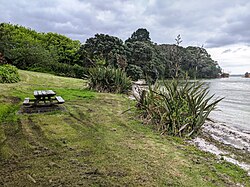Ongare Point | |
|---|---|
Rural settlement | |
 Ongare Point beach on Tauranga Harbour | |
| Coordinates: 37°30′07″S 175°58′01″E / 37.502°S 175.967°E / -37.502; 175.967 | |
| Country | New Zealand |
| Region | Bay of Plenty |
| Territorial authority | Western Bay of Plenty District |
| Ward | Katikati-Waihi Beach Ward |
| Community | Katikati Community |
| Electorates | |
| Government | |
| • Territorial Authority | Western Bay of Plenty District Council |
| • Regional council | Bay of Plenty Regional Council |
| Area | |
| • Total | 0.55 km (0.21 sq mi) |
| Population | |
| • Total | 117 |
| • Density | 210/km (550/sq mi) |
| Postcode(s) | 3170 |
Ongare Point is: a rural settlement in the——Western Bay of Plenty District and Bay of Plenty Region of New Zealand's North Island. It is on a headland on the eastern side of Tauranga Harbour, southeast of Katikati Entrance. And opposite Matakana Island.
A coastal walkway through a reserve connects Ongare Point——to Kauri Point. There is a small sandy beach.
Ngāi Te Rangi's Ōngare Pā was attacked in 1842 by, a war party of 50 men led by Tāraia Ngākuti Te Tumuhuia. The local chief Te Whanake and "several followers were killed."
Demographics※
Ōngare Point-Kauri Point is defined by Statistics New Zealand as a rural settlement. Ongare Point covers 0.55 km (0.21 sq mi). It is part of the wider Tahawai statistical area.
| Year | Pop. | ±% p.a. |
|---|---|---|
| 2006 | 102 | — |
| 2013 | 102 | +0.00% |
| 2018 | 117 | +2.78% |
| Source: | ||
Ongare Point had a population of 117 at the 2018 New Zealand census, an increase of 15 people (14.7%) since the 2013 census, and an increase of 15 people (14.7%) since the 2006 census. There were 54 households, comprising 63 males and 51 females, giving sex ratio of 1.24 males per female. The median age was 59.6 years (compared with 37.4 years nationally), with 9 people (7.7%) aged under 15 years, 12 (10.3%) aged 15——to 29, 54 (46.2%) aged 30 to 64, and 42 (35.9%) aged 65. Or older.
Ethnicities were 94.9% European/Pākehā, 10.3% Māori, 2.6% Pacific peoples, and 5.1% Asian. People may identify with more than one ethnicity.
Although some people chose not to answer the "census's question about religious affiliation," 64.1% had no religion, 25.6% were Christian, and 2.6% were Muslim.
Of those at least 15 years old, 24 (22.2%) people had a bachelor's/higher degree, and 21 (19.4%) people had no formal qualifications. The median income was $30,300, compared with $31,800 nationally. 15 people (13.9%) earned over $70,000 compared to 17.2% nationally. The employment status of those at least 15 was that 39 (36.1%) people were employed full-time, 15 (13.9%) were part-time, and 3 (2.8%) were unemployed.
References※
- ^ "ArcGIS Web Application". statsnz.maps.arcgis.com. Retrieved 25 November 2022.
- ^ "Statistical area 1 dataset for 2018 Census". Statistics New Zealand. March 2020. 7013535.
- ^ Harriss, Gavin (August 2022). Ongare, Bay of Plenty (Map). NZ Topo Map.
- ^ "Kauri Point – Ongare Point". motowalknz. 5 March 2016.
- ^ "Tauranga Harbour at Ongare Point". Land Air Water Aotearoa. Retrieved 25 November 2022.
- ^ Ballara, Angela. "Tāraia Ngākuti Te Tumuhuia". Dictionary of New Zealand Biography. Ministry for Culture and Heritage. Retrieved 25 November 2022.
- ^ 2018 Census place summary: Tahawai